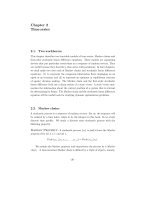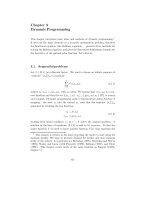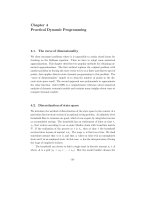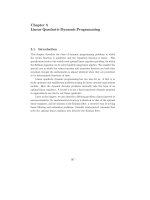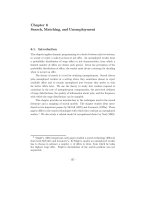Recursive macroeconomic theory, Thomas Sargent 2nd Ed - Chapter 17 pdf
Bạn đang xem bản rút gọn của tài liệu. Xem và tải ngay bản đầy đủ của tài liệu tại đây (381.48 KB, 48 trang )
Chapter 17
Incomplete Markets Models
17.1. Introduction
In the complete markets model of chapter 8, the optimal consumption alloca-
tion is not history dependent: the allocation depends on the current value of
the Markov state variable only. This outcome reflects the comprehensive op-
portunities to insure risks that markets provide. This chapter and chapter 19
describe settings with more impediments to exchanging risks. These reduced
opportunities make allocations history dependent. In this chapter, the history
dependence is encoded in the dependence of a household’s consumption on the
household’s current asset holdings. In chapter 19, history dependence is en-
coded in the dependence of the consumption allocation on a continuation value
promised by a planner or principal.
The present chapter describes a particular type of incomplete markets
model. The models have a large number of ex ante identical but ex post het-
erogeneous agents who trade a single security. For most of this chapter, we
study models with no aggregate uncertainty and no variation of an aggregate
state variable over time (so macroeconomic time series variation is absent). But
there is much uncertainty at the individual level. Households’ only option is to
“self-insure” by managing a stock of a single asset to buffer their consumption
against adverse shocks. We study several models that differ mainly with respect
to the particular asset that is the vehicle for self-insurance, for example, fiat
currency or capital.
The tools for constructing these models are discrete-state discounted dy-
namic programming—used to formulate and solve problems of the individuals;
and Markov chains—used to compute a stationary wealth distribution. The
models produce a stationary wealth distribution that is determined simultane-
ously with various aggregates that are defined as means across corresponding
individual-level variables.
– 561 –
562 Incomplete Markets Models
We begin by recalling our discrete state formulation of a single-agent infinite
horizon savings problem. We then describe several economies in which house-
holds face some version of this infinite horizon saving problem, and where some
of the prices taken parametrically in each household’s problem are determined
by the average behavior of all households.
1
This class of models was invented by Bewley (1977, 1980, 1983, 1986) partly
to study a set of classic issues in monetary theory. The second half of this chapter
joins that enterprise by using the model to represent inside and outside money, a
free banking regime, a subtle limit to the scope of Friedman’s optimal quantity of
money, a model of international exchange rate indeterminacy, and some related
issues. The chapter closes by describing some recent work of Krusell and Smith
(1998) designed to extend the domain of such models to include a time-varying
stochastic aggregate state variable. As we shall see, this innovation makes the
state of the household’s problem include the time-t cross-section distribution of
wealth, an immense object.
Researchers have used calibrated versions of Bewley models to give quanti-
tative answers to questions including the welfare costs of inflation (
˙
Imrohoro˘glu,
1992), the risk-sharing benefits of unfunded social security systems (
˙
Imrohoro˘glu,
˙
Imrohoro˘glu, and Joines, 1995), the benefits of insuring unemployed people
(Hansen and
˙
Imrohoro˘glu, 1992), and the welfare costs of taxing capital (Aiya-
gari, 1995).
1
Most of the heterogeneous agent models in this chapter have been arranged
to shut down aggregate variations over time, to avoid the “curse of dimensional-
ity” that comes into play in formulating the household’s dynamic programming
problem when there is an aggregate state variable. But we also describe a model
of Krusell and Smith (1998) that has an aggregate state variable.
A savings problem 563
17.2. A savings problem
Recall the discrete state saving problem described in chapters 4 and 16. The
household’s labor income at time t, s
t
, evolves according to an m-state Markov
chain with transition matrix P. If the realization of the process at t is ¯s
i
,
then at time t the household receives labor income w¯s
i
. Thus, employment
opportunities determine the labor income process. We shall sometimes assume
that m is 2, and that s
t
takes the value 0 in an unemployed state and 1 in an
employed state.
We constrain holdings of a single asset to a grid A =[0<a
1
<a
2
< <
a
n
]. For given values of (w, r) and given initial values (a
0
,s
0
) the household
chooses a policy for {a
t+1
}
∞
t=0
to maximize
E
0
∞
t=0
β
t
u(c
t
), (17.2.1)
subject to
c
t
+ a
t+1
=(1+r)a
t
+ ws
t
a
t+1
∈A
(17.2.2)
where β ∈ (0, 1) is a discount factor; u(c) is a strictly increasing, strictly
concave, twice continuously differentiable one-period utility function satisfying
the Inada condition lim
c↓0
u
(c)=+∞;and β(1 + r) < 1.
2
The Bellman equation, for each i ∈ [1, ,m]andeachh ∈ [1, ,n], is
v(a
h
, ¯s
i
)=max
a
∈A
{u[(1 + r)a
h
+ w¯s
i
− a
]+β
m
j=1
P(i, j)v(a
, ¯s
j
)}, (17.2.3)
where a
is next period’s value of asset holdings. Here v(a, s)istheoptimal
value of the objective function, starting from asset-employment state (a, s).
Note that the grid A incorporates upper and lower limits on the quantity that
can be borrowed (i.e., the amount of the asset that can be issued). The upper
bound on A is restrictive. In some of our theortical discussion to follow, it will
be important to dispense with that upper bound.
In chapter 16, we described how to solve equation (17.2.3) for a value
function v(a, s) and an associated policy function a
= g(a, s) mapping this
period’s (a, s) pair into an optimal choice of assets to carry into next period.
2
The Inada condition makes consumption nonnegative, and this fact plays a
role in justifying the natural debt limit below.
564 Incomplete Markets Models
17.2.1. Wealth-employment distributions
Define the unconditional distribution of (a
t
,s
t
)pairs,λ
t
(a, s)=Prob(a
t
=
a, s
t
= s). The exogenous Markov chain P on s and the optimal policy function
a
= g(a, s) induce a law of motion for the distribution λ
t
,namely,
Prob(s
t+1
= s
,a
t+1
= a
)=
a
t
s
t
Prob(a
t+1
= a
|a
t
= a, s
t
= s)
·Prob(s
t+1
= s
|s
t
= s) · Prob(a
t
= a, s
t
= s),
or
λ
t+1
(a
,s
)=
a
s
λ
t
(a, s)Prob(s
t+1
= s
|s
t
= s) ·I(a
,s,a),
where we define the indicator function I(a
,a,s)=1ifa
= g(a, s), and 0
otherwise.
3
The indicator function I(a
,a,s) = 1 identifies the time-t states
a, s that are sent into a
at time t+1. The preceding equation can be expressed
as
λ
t+1
(a
,s
)=
s
{a:a
=g(a,s)}
λ
t
(a, s)P(s, s
). (17.2.4)
A time-invariant distribution λ that solves equation (17.2.4) (i.e., one for which
λ
t+1
= λ
t
) is called a stationary distribution. One way to compute a stationary
distribution is to iterate to convergence on equation (17.2.4). An alternative is
to create a Markov chain that describes the solution of the optimum problem,
then to compute an invariant distribution from a left eigenvector associated with
a unit eigenvalue of the stochastic matrix (see chapter 2).
To deduce this Markov chain, we map the pair (a, s) of vectors into a
single-state vector x as follows. For i =1, ,n, h =1, ,m,letthej th
element of x be the pair (a
i
,s
h
), where j =(i − 1)m + h. Thus, we denote
x
=[(a
1
,s
1
), (a
1
,s
2
), ,(a
1
,s
m
), (a
2
,s
1
), ,
(a
2
,s
m
), ,(a
n
,s
1
), ,(a
n
,s
m
)]. The optimal policy function a
= g(a, s)
and the Markov chain P on s induce a Markov chain on x
t
via the formula
Prob[(a
t+1
= a
,s
t+1
= s
)|(a
t
= a, s
t
= s)]
=Prob(a
t+1
= a
|a
t
= a, s
t
= s) · Prob(s
t+1
= s
|s
t
= s)
= I(a
,a,s)P(s, s
),
3
This construction exploits the fact that the optimal policy is a deterministic
function of the state, which comes from the concavity of the objective function
and the convexity of the constraint set.
A savings problem 565
where I(a
,a,s) = 1 is defined as above. This formula defines an N ×N matrix
P ,whereN = n ·m. This is the Markov chain on the household’s state vector
x.
4
Suppose that the Markov chain associated with P is asymptotically sta-
tionary and has a unique invariant distribution π
∞
. Typically, all states in the
Markov chain will be recurrent, and the individual will occasionally revisit each
state. For long samples, the distribution π
∞
tells the fraction of time that the
household spends in each state. We can “unstack” the state vector x and use
π
∞
to deduce the stationary probability measure λ(a
i
,s
h
)over(a, s)pairs,
where
λ(a
i
,s
h
)=Prob(a
t
= a
i
,s
t
= s
h
)=π
∞
(j),
and where π
∞
(j)isthej th component of the vector π
∞
,andj =(i −1)m+h.
17.2.2. Reinterpretation of the distribution λ
The solution of the household’s optimum saving problem induces a stationary
distribution λ(a, s) that tells the fraction of time that an infinitely lived agent
spends in state (a, s). We want to reinterpret λ(a, s). Thus, let (a, s) index
the state of a particular household at a particular time period t,andassume
that there is a probability distribution of households over state (a, s). We start
the economy at time t = 0 with a distribution λ(a, s) of households that we
want to repeat itself over time. The models in this chapter arrange the initial
distribution and other things so that the distribution of agents over individual
state variables (a, s) remains constant over time even though the state of the
individual household is a stochastic process. We shall study several models of
this type.
4
Various Matlab programs to be described later in this chapter create the
Markov chain for the joint (a, s) state.
566 Incomplete Markets Models
17.2.3. Example 1: A pure credit model
Mark Huggett (1993) studied a pure exchange economy. Each of a continuum
of households has access to a centralized loan market in which it can borrow or
lend at a constant net risk-free interest rate of r. Each household’s endowment is
governed by the Markov chain (P, ¯s). The household can either borrow or lend
at a constant risk-free rate. However, total borrowings cannot exceed φ>0,
where φ is a parameter set by Huggett. A household’s setting of next period’s
level of assets is restricted to the discrete set A =[a
1
, ,a
m
], where the lower
bound on assets a
1
= −φ. Later we’ll discuss alternative ways to set φ,and
how it relates to a natural borrowing limit.
The solution of the household’s problem is a policy function a
= g(a, s)
that induces a stationary distribution λ(a, s) over states. Huggett uses the
following definition:
Definition: Given φ,astationary equilibrium is an interest rate r , a policy
function g(a, s), and a stationary distribution λ(a, s)forwhich
a. The policy function g(a, s) solves the household’s optimum problem.
b. The stationary distribution λ(a, s) is induced by (P, ¯s)andg(a, s).
c. The loan market clears
a,s
λ(a, s)g(a, s)=0.
17.2.4. Equilibrium computation
Huggett computed equilibria by using an iterative algorithm. He fixed an r = r
j
for j = 0, and for that r solved the household’s problem for a policy function
g
j
(a, s) and an associated stationary distribution λ
j
(a, s). Then he checked to
see whether the loan market clears at r
j
by computing
a,s
λ
j
(a, s)g(a, s)=e
∗
j
.
If e
∗
j
> 0, Huggett raised r
j+1
above r
j
and recomputed excess demand, con-
tinuing these iterations until he found an r at which excess demand for loans is
zero.
A savings problem 567
17.2.5. Example 2: A model with capital
The next model was created by Rao Aiyagari (1994). He used a version of
the saving problem in an economy with many agents and interpreted the single
asset as homogeneous physical capital, denoted k. The capital holdings of a
household evolve according to
k
t+1
=(1−δ)k
t
+ x
t
where δ ∈ (0, 1) is a depreciation rate and x
t
is gross investment. The house-
hold’s consumption is constrained by
c
t
+ x
t
=˜rk
t
+ ws
t
,
where ˜r is the rental rate on capital and w is a competitive wage, to be deter-
mined later. The preceding two equations can be combined to become
c
t
+ k
t+1
=(1+˜r − δ)k
t
+ ws
t
,
which agrees with equation (17.2.2) if we take a
t
≡ k
t
and r ≡ ˜r − δ.
There is a large number of households with identical preferences (17.2.1)
whose distribution across (k, s) pairs is given by λ(k,s), and whose average
behavior determines (w, r) as follows: Households are identical in their pref-
erences, the Markov processes governing their employment opportunities, and
the prices that they face. However, they differ in their histories s
t
0
= {s
h
}
t
h=0
of employment opportunities, and therefore in the capital that they have ac-
cumulated. Each household has its own history s
t
0
as well as its own initial
capital k
0
. The productivity processes are assumed to be independent across
households. The behavior of the collection of these households determines the
wage and interest rate (w, r).
Assume an initial distribution across households of λ(k, s). The average
level of capital per household K satisfies
K =
k,s
λ(k, s)g(k, s),
where k
= g(k,s). Assuming that we start from the invariant distribution, the
average level of employment is
N = ξ
∞
¯s,
568 Incomplete Markets Models
where ξ
∞
is the invariant distribution associated with P and ¯s is the exoge-
nously specified vector of individual employment rates. The average employment
rate is exogenous to the model, but the average level of capital is endogenous.
There is an aggregate production function whose arguments are the average
levels of capital and employment. The production function determines the rental
rates on capital and labor from the marginal conditions
w = ∂F(K, N)/∂N
˜r = ∂F(K, N)/∂K
where F (K, N)=AK
α
N
1−α
and α ∈ (0, 1).
We now have identified all of the objects in terms of which a stationary
equilibrium is defined.
Definition of Equilibrium: A stationary equilibrium is a policy func-
tion g(k, s), a probability distribution λ(k,s), and positive real numbers (K, ˜r, w)
such that
a. The prices (w, r)satisfy
w = ∂F(K, N)/∂N
r = ∂F(K, N)/∂K −δ.
(17.2.5)
b. The policy function g(k, s) solves the household’s optimum problem.
c. The probability distribution λ(k, s) is a stationary distribution associated
with [g(k, s), P]; that is, it satisfies
λ(k
,s
)=
s
{k:k
=g(k,s)}
λ(k, s)P(s, s
).
d. The average value of K is implied by the average the households’ decisions
K =
k,s
λ(k, s)g(k, s).
A savings problem 569
17.2.6. Computation of equilibrium
Aiyagari computed an equilibrium of the model by defining a mapping from
K ∈ IR into IR , with the property that a fixed point of the mapping is an
equilibrium K . Here is an algorithm for finding a fixed point:
1. For fixed value of K = K
j
with j = 0 , compute (w, r)fromequation
(17.2.5), then solve the household’s optimum problem. Use the optimal
policy g
j
(k, s) to deduce an associated stationary distribution λ
j
(k, s).
2. Compute the average value of capital associated with λ
j
(k, s), namely,
K
∗
j
=
k,s
λ
j
(k, s)g
j
(k, s).
3. For a fixed “relaxation parameter” ξ ∈ (0, 1), compute a new estimate of
K from method
5
K
j+1
= ξK
j
+(1− ξ)K
∗
j
.
4. Iterate on this scheme to convergence.
Later, we shall display some computed examples of equilibria of both Huggett’s
model and Aiyagari’s model. But first we shall analyze some features of both
models more formally.
5
By setting ξ<1, the relaxation method often converges to a fixed point in
cases in which direct iteration (i.e., setting ξ = 0) fails to converge.
570 Incomplete Markets Models
17.3. Unification and further analysis
We can display salient features of several models by using a graphical apparatus
of Aiyagari (1994). We shall show relationships among several models that have
identical household sectors but make different assumptions about the single asset
being traded.
For convenience, recall the basic savings problem. The household’s objec-
tive is to maximize
E
0
∞
t=0
β
t
u(c
t
)(17.3.1a)
c
t
+ a
t+1
= ws
t
+(1+r)a
t
(17.3.1b)
subject to the borrowing constraint
a
t+1
≥−φ. (17.3.1c)
We now temporarily suppose that a
t+1
can take any real value exceeding −φ.
Thus, we now suppose that a
t
∈ [− φ, +∞). We occasionally find it useful to
express the discount factor β ∈ (0, 1) in terms of a discount rate ρ as β =
1
1+ρ
.
In equation (17.3.1b), w is sometimes a given function ψ(r) of the net interest
rate r .
17.4. Digression: the nonstochastic savings problem
It is useful briefly to study the nonstochastic version of the savings problem
when β(1 + r) < 1. For β(1 +r) = 1, we studied this problem in chapter 16. To
get the nonstochastic savings problem, assume that s
t
is fixed at some positive
level s. Associated with the household’s maximum problem is the Lagrangian
L =
∞
t=0
β
t
{u(c
t
)+θ
t
[(1 + r)a
t
+ ws − c
t
− a
t+1
]}, (17.4.1)
where {θ
t
}
∞
t=0
is a sequence of nonnegative Lagrange multipliers on the budget
constraint. The first-order conditions for this problem are
u
(c
t
) ≥ β(1 + r)u
(c
t+1
), =if a
t+1
> −φ. (17.4.2)
Digression: the nonstochastic savings problem 571
When a
t+1
> −φ, the first-order condition implies
u
(c
t+1
)=
1
β(1 + r)
u
(c
t
), (17.4.3)
which because β(1+r) < 1 in turn implies that u
(c
t+1
) >u
(c
t
)andc
t+1
<c
t
.
Thus, consumption is declining during periods when the household is not bor-
rowing constrained. Thus, {c
t
} is a monotone decreasing sequence. If it is
bounded below, either because of an Inada condition on u(·) at 0 or a nonneg-
ativity constraint on c
t
,thenc
t
will converge as t → +∞.Whenitconverges,
the household will be borrowing constrained.
We can compute the steady level of consumption when the household even-
tually becomes permanently stuck at the borrowing constraint. Set a
t+1
= a
t
=
−φ. This and (17.3.1b)gives
c
t
=¯c = ws − rφ. (17.4.4)
This is the level of labor income left after paying the net interest on the debt
at the borrowing limit. The household would like to shift consumption from
tomorrow to today but can’t.
If we solve the budget constraint forward, we obtain the present-value bud-
get constraint
a
0
=(1+r)
−1
∞
t=0
(1 + r)
−t
(c
t
− ws). (17.4.5)
Thus, when β(1 + r) < 1, the household’s consumption plan can be found from
solving equations (17.4.5), (17.4.4), and (17.4.3) for an initial c
0
and a date T
after which the debt limit is binding and c
t
is constant.
If consumption is required to be nonnegative,
6
equation (17.4.4) implies
that the debt limit must satisfy
φ ≤
ws
r
. (17.4.6)
We call the right side the natural debt limit.Ifφ<
ws
r
, we say that there is an
ad hoc debt limit.
We have deduced that when β(1 + r) < 1, if a steady-state level exists,
consumption is given by equation (17.4.4) and assets by a
t
= −φ.
6
Consumption must be nonnegative, for example, if we impose the Inada
condition discussed earlier.
572 Incomplete Markets Models
Now turn to the case that β(1+r)=1.Hereequation(17.4.3) implies that
c
t+1
= c
t
and the budget constraint implies c
t
= ws + ra and a
t+1
= a
t
= a
0
.
So when β(1 + r)=1,any a
0
is a stationary value of a.Itisoptimalforever
to roll over the initial asset level.
In summary, in the deterministic case, the steady-state demand for assets
is −φ when (1 + r) <β
−1
(i.e., when r<ρ); and it equals a
0
when r = ρ.
Letting the steady-state level be ¯a,wehave
¯a =
−φ, if r<ρ;
a
0
, if r = ρ,
where β =(1+ρ)
−1
.Whenr = ρ, we say that the steady state asset level ¯a
is indeterminate.
17.5. Borrowing limits: “natural” and “ad hoc”
We return to the stochastic case and take up the issue of debt limits. Imposing
c
t
≥ 0 implies the emergence of what Aiyagari calls a “natural” debt limit.
Thus, imposing c
t
≥ 0 and solving equation (17.3.1b) forward gives
a
t
≥−
1
1+r
∞
j=0
ws
t+j
(1 + r)
−j
. (17.5.1)
Since the right side is a random variable, not known at t, we have to supplement
equation (17.5.1) to obtain the borrowing constraint. One possible approach is
to replace the right side of equation (17.5.1) with its conditional expectation,
and to require equation (17.5.1) to hold in expected value. But this expected
value formulation is incompatible with the notion that the loan is risk free, and
that the household can repay it for sure. If we insist that equation (17.5.1)
hold almost surely, for all t ≥ 0, then we obtain the constraint that emerges by
replacing s
t
with min s ≡ s
1
, which yields
a
t
≥−
s
1
w
r
. (17.5.2)
Aiyagari (1994) calls this the “natural debt limit.” To accommodate possibly
more stringent debt limits, beyond those dictated by the notion that it is feasible
to repay the debt for sure, Aiyagari specifies the debt limit as
a
t
≥−φ, (17.5.3)
Borrowing limits: “natural” and “ad hoc” 573
where
φ =min
b,
s
1
w
r
, (17.5.4)
and b>0 is an arbitrary parameter defining an “ad hoc” debt limit.
17.5.1. A candidate for a single state variable
For the special case in which s is i.i.d., Aiyagari showed how to cast the model in
terms of a single state variable to appear in the household’s value function. To
synthesize a single state variable, note that the “disposable resources” available
to be allocated at t are z
t
= ws
t
+(1+r)a
t
+ φ.Thus,z
t
is the sum of
the current endowment, current savings at the beginning of the period, and the
maximimal borrowing capacity φ. This can be rewritten as
z
t
= ws
t
+(1+r)ˆa
t
− rφ
where ˆa
t
≡ a
t
+ φ. In terms of the single state variable z
t
, the household’s
budget set can be represented recursively as
c
t
+ˆa
t+1
≤ z
t
(17.5.5a)
z
t+1
= ws
t+1
+(1+r)ˆa
t+1
− rφ (17.5.5b)
wherewemusthaveˆa
t+1
≥ 0. The Bellman equation is
v(z
t
,s
t
)= max
ˆa
t+1
≥0
{u(z
t
− ˆa
t+1
)+βEv(z
t+1
,s
t+1
)}. (17.5.6)
Here s
t
appears in the state vector purely as an information variable for predict-
ing the employment component s
t+1
of next period’s disposable resources z
t+1
,
conditional on the choice of ˆa
t+1
made this period. Therefore, it disappears
from both the value function and the decision rule in the i.i.d. case.
More generally, with a serially correlated state, associated with the solution
of the Bellman equation is a policy function
ˆa
t+1
= A(z
t
,s
t
). (17.5.7)
574 Incomplete Markets Models
17.5.2. Supermartingale convergence again
Let’s revisit a main issue from chapter 16, but now consider the possible case
β(1 + r) < 1. From equation (17.5.5a), optimal consumption satisfies c
t
=
z
t
− A(z
t
,s
t
). The optimal policy obeys the Euler inequality:
u
(c
t
) ≥ β(1 + r)E
t
u
(c
t+1
), =ifˆa
t+1
> 0. (17.5.8)
We can use equation (17.5.8) to deduce significant aspects of the limiting be-
havior of mean assets as a function of r. Following Chamberlain and Wilson
(2000) and others, to deduce the effect of r on the mean of assets, we analyze
the limiting behavior of consumption implied by the Euler inequality (17.5.8).
Define
M
t
= β
t
(1 + r)
t
u
(c
t
) ≥ 0.
Then M
t+1
−M
t
= β
t
(1 + r)
t
[β(1 + r)u
(c
t+1
) −u
(c
t
)]. Equation (17.5.8) can
be written
E
t
(M
t+1
− M
t
) ≤ 0, (17.5.9)
which asserts that M
t
is a supermartingale. Because M
t
is nonnegative, the
supermartingale convergence theorem applies. It asserts that M
t
converges
almost surely to a nonnegative random variable
¯
M : M
t
→
a.s.
¯
M .
It is interesting to consider three cases: (1) β(1 + r) > 1; (2) β(1 + r) < 1,
and (3) β(1 + r) = 1. In case 1, the fact that M
t
converges implies that u
(c
t
)
converges to zero almost surely. If u(·) is unbounded (has no satiation point),
this fact then implies that c
t
→ +∞ and that the consumer’s asset holdings
must be diverging to +∞. Chamberlain and Wilson (2000) show that such
results also characterize the borderline case (3) (see chapter 16). In case 2,
convergence of M
t
leaves open the possibility that u
(c) does not converge a.s.,
that it remains finite and continues to vary randomly. Indeed, when β(1+r) < 1,
the average level of assets remains finite, and so does the level of consumption.
It is easier to analyze the borderline case β(1 + r) = 1 in the special
case that the employment process is independently and identically distributed,
meaning that the stochastic matrix P has identical rows.
7
In this case, s
t
provides no information about z
t+1
,andsos
t
can be dropped as an argument
of both v(·)andA(·). For the case in which s
t
is i. i. d., Aiyagari (1994) uses
7
See chapter 16 for a closely related proof.
Average assets as function of r 575
the following argument by contradiction to show that if β(1 + r)=1,then
z
t
diverges to +∞. Assume that there is some upper limit z
max
such that
z
t+1
≤ z
max
= ws
max
+(1+r)A(z
max
) − rφ. Then when β(1 + r)=1,the
strict concavity of the value function, the Benveniste-Scheinkman formula, and
equation (17.5.8) imply
v
(z
max
) ≥ E
t
v
ws
t+1
+(1+r)A(z
max
) − rφ
>v
[ws
max
+(1+r)A(z
max
) − rφ]=v
(z
max
),
which is a contradiction.
17.6. Average assets as function of r
In the next several sections we use versions of a graph of Aiyagari (1994) to
analyze several models. The graph plots the average level of assets as a function
of r. In the model with capital, the graph is constructed to incorporate the
equilibrium dependence of the wage w on r . In models without capital, like
Huggett’s, the wage is fixed. We shall focus on situations where β(1 + r) < 1.
We consider cases where the optimal decision rule A(z
t
,s
t
)andtheMarkov
chain for s induce a Markov chain jointly for assets and s that has a unique
invariant distribution. For fixed r,letEa(r) denote the mean level of assets
a and let Eˆa(r)=Ea(r)+φ be the mean level of a + φ,wherethemean
is taken with respect to the invariant distribution. Here it is understood that
Ea(r) is a function of φ; when we want to make the dependence explicit we
write Ea(r; φ). Also, as we have said, where the single asset is capital, it is
appropriate to make the wage w a function of r . This approach incorporates
the way different values of r affect average capital, the marginal product of
labor, and therefore the wage.
The preceding analysis applying supermartingale convergence implies that
as β(1 + r) goes to 1 from below (i.e., r goes to ρ from below), Ea(r)diverges
to +∞. This feature is reflected in the shape of the Ea(r) curve in Fig. 17.6.1.
8
8
As discussed in Aiyagari (1994), Ea(r) need not be a monotonically in-
creasing function of r , especially because w can be a function of r .
576 Incomplete Markets Models
r
ρ
r
1
E a (r)
K
1
K
F
K
− δ
r
2
0
− w s / r
1
− b
K
0
Figure 17.6.1: Demand for capital and determination of
interest rate.
Figure 17.6.1 assumes that the wage w is fixed in drawing the Ea(r)curve.
Later, we will discuss how to draw a similar curve, making w adjust as the
function of r that is induced by the marginal productivity conditions for positive
values of K . For now, we just assume that w is fixed at the value equal to the
marginal product of labor when K = K
1
, the equilibrium level of capital in
the model. The equilibrium interest rate is determined at the intersection of
the Ea(r) curve with the marginal productivity of capital curve. Notice that
the equilibrium interest rate r is lower than ρ, its value in the nonstochastic
version of the model, and that the equilibrium value of capital K
1
exceeds the
equilibrium value K
0
(determined by the marginal productivity of capital at
r = ρ in the nonstochastic version of the model.)
For a pure credit version of the model like Huggett’s, but the same Ea(r)
curve, the equilibrium interest rate is determined by the intersection of the
Ea(r) curve with the r axis.
For the purpose of comparing some of the models that follow, it is useful
to note the following aspect of the dependence of Ea(0) on φ:
Average assets as function of r 577
K
r
KK
r
10
-b
- w /r
1
ρ
E a(r)
F -
Κ
δ
0
Figure 17.6.2: Demand for capital and determination of
interest rate. The Ea(r) curve is constructed for a fixed wage
that equals the marginal product of labor at level of capital
K
1
. In the nonstochastic version of the model with capital,
the equilibrium interest rate and capital stock are (ρ, K
0
),
while in the stochastic version they are (r, K
1
). For a version
of the model without capital in which w is fixed at this same
fixed wage, the equilibrium interest rate in Huggett’s pure
credit economy occurs at the intersection of the Ea(r)curve
with the r axis.
Proposition 1: When r =0,theoptimalruleˆa
t+1
= A(z
t
,s
t
) is indepen-
dent of φ.Thisimpliesthatforφ>0, Ea(0; φ)=Ea(0; 0) − φ.
Proof: It is sufficient to note that when r =0,φ disappears from the right side of
equation (17.5.5b) (the consumer’s budget constraint). Therefore, the optimal
rule ˆa
t+1
= A(z
t
,s
t
) does not depend on φ when r = 0. More explicitly, when
r =0,add φ to both sides of the household’s budget constraint to get
(a
t+1
+ φ)+c
t
≤ (a
t
+ φ)+ws
t
.
If the household’s problem with φ = 0 is solved by the decision rule a
t+1
=
g(a
t
,z
t
), then the household’s problem with φ>0issolvedwiththesame
decision rule evaluated at a
t+1
+ φ = g(a
t
+ φ, z
t
).
578 Incomplete Markets Models
E a(r, )φ
φ
φ
r
E a (r,0)
E a(r)
0
Figure 17.6.3: The effect of a shift in φ on the Ea(r)curve.
Both Ea(r) curves are drawn assuming that the wage is fixed.
Thus, it follows that at r =0,anincreasein φ displaces the Ea(r)curve
to the left by the same amount. See Figure 17.6.3. We shall use this result to
analyze several models.
In the following sections, we use a version Figure 17.6.1 to compute equilib-
ria of various models. For models without capital, the figure is drawn assuming
that the wage is fixed. Typically, the Ea(r) curve will have the same shape
as Figure 14.1. In Huggett’s model, the equilibrium interest rate is determined
by the intersection of the Ea(r) curve with the r-axis, reflecting that the as-
set (pure consumption loans) is available in zero net supply. In some models
with money, the availability of a perfect substitute for consumption loans (fiat
currency) creates positive net supply.
Computed examples 579
−4 −2 0 2 4 6 8 10 12
−0.01
0
0.01
0.02
0.03
0.04
0.05
interest rate
w = 1, b = 3 / b = 6
Figure 17.6.4: Two Ea(r)curves,onewithb = 6 , the other
with b =3,withw fixed at w =1. Noticethatatr −0, the
difference between the two curves is 3, the difference in the
b’s.
17.7. Computed examples
We used some Matlab programs that solve discrete-state dynamic programming
problems to compute some examples.
9
We discretized the space of assets from
−φ to a parameter a
max
=16withstepsize.2.
The utility function is u(c)=(1−µ)
−1
c
1−µ
,withµ =3. Weset β = .96.
We used two specifications of the Markov process for s. First, we used Tauchen’s
(1986) method to get a discrete-state Markov chain to approximate a first-order
autoregressive process
log s
t
= ρ log s
t−1
+ u
t
,
where u
t
is a sequence of i.i.d. Gaussian random variables. We set ρ = .2and
the standard deviation of u
t
equal to .4
(1 − ρ)
2
.WeusedTauchen’smethod
with N = 7 being the number of points in the grid for s.
9
The Matlab programs used to compute the Ea(r) functions are bewley99.m,
bewley99v2.m, aiyagari2.m, bewleyplot.m,andbewleyplot2.m. The pro-
gram markovapprox.m implements Tauchen’s method for approximating a con-
tinuous autoregressive process with a Markov chain. A program markov.m sim-
ulates a Markov chain.
580 Incomplete Markets Models
For the second specification, we assumed that s is i.i.d. with mean 1.0903.
For this case, we compared two settings for the variance: .22 and .68. Figures
17.6.4 and 17.7.1 plot the Ea(r) curves for these various specifications. Figure
17.7.1 plots Ea(r) for the first case of serially correlated s.ThetwoE[a(r)]
curves correspond to two distinct settings of the ad hoc debt constraint. One is
for b = 3, the other for b = 6. Figure 17.7.2 plots the invariant distribution of
asset holdings for the case in which b = 3 and the interest rate is determined
at the intersection of the Ea(r) curve and the r axis.
Figure 17.7.1 summarizes a precautionary savings experiment for the i.i.d.
specification of s.TwoEa(r) curves are plotted. For each, we set the ad hoc
debt limit b =0. TheEa(r) curve further to the right is the one for the higher
variance of the endowment shock s. Thus, a larger variance in the random
shock causes increased savings.
0 1 2 3 4 5 6 7 8 9 10
−0.01
0
0.01
0.02
0.03
0.04
0.05
interest rate
Figure 17.7.1: Two Ea(r) curves when b =0andthe
endowment shock s is i.i.d. but with different variances; the
curve with circles belongs to the economy with the higher
variance.
Keep these graphs in mind as we turn to analyze some particular models in
more detail.
Several Bewley models 581
−3 −2 −1 0 1 2 3 4
0.01
0.02
0.03
0.04
0.05
0.06
0.07
0.08
0.09
0.1
b=3, r=0
Figure 17.7.2: The invariant distribution of capital when
b =3.
17.8. Several Bewley models
We consider several models in which a continuum of households faces the same
problem. Their behavior generates the asset demand function Ea(r; φ). The
models share the same family of Ea(r; φ) curves, but differ in their settings
of φ and in their interpretations of the supply of the asset. The models are
(1) Aiyagari’s (1994, 1995) model in which the risk-free asset is either physical
capital or private IOUs, with physical capital being the net supply of the asset;
(2) Huggett’s model (1993), where the asset is private IOUs, available in zero
net supply; (3) Bewley’s model of fiat currency; (4) modifications of Bewley’s
model to permit an inflation tax; and (5) modifications of Bewley’s model to
pay interest on currency, either explicitly or implicitly through deflation.
582 Incomplete Markets Models
17.8.1. Optimal stationary allocation
Because there is no aggregate risk and the aggregate endowment is constant,
a stationary optimal allocation would have consumption constant over time
for each household. Each household’s consumption plan would have constant
consumption over time. The implicit risk-free interest rate associated with such
an allocation would be r = ρ. In the version of the model with capital, the
stationary aggregate capital stock solves
F
K
(K, N) −δ = ρ. (17.8.1)
Equation (17.8.1) restricts the stationary optimal capital stock in the non-
stochastic optimal growth model of Cass (1965) and Koopmans (1965). The
stationary level of capital is K
0
in Figure 17.6.1, depicted as the ordinate of
the intersection of the marginal productivity net of depreciation curve with a
horizontal line r = ρ. As we saw before, the horizontal line at r = ρ acts as
a “long-run” demand curve for savings for a nonstochastic version of the sav-
ings problem. The stationary optimal allocation matches the one produced by
a nonstochastic growth model. We shall use the risk-free interest rate r = ρ
as a benchmark against which to compare some alternative incomplete market
allocations. Aiyagari’s (1994) model replaces the horizontal line r = ρ with an
upward sloping curve Ea(r), causing the stationary equilibrium interest rate to
fall and the capital stock to rise relative to the risk-free model.
17.9. A model with capital and private IOUs
Figure 17.6.1 can be used to depict the equilibrium of Aiyagari’s model described
above. The single asset is capital. There is an aggregate production function
Y = F (K, N), and w = F
N
(K, N), r + δ = F
K
(K, N). We can invert the
marginal condition for capital to deduce a downward-sloping curve K = K(r).
This is drawn as the curve labelled F
K
− δ in Figure 17.6.1. We can use the
marginal productivity conditions to deduce a factor price frontier w = ψ(r).
For fixed r,weusew = ψ(r) as the wage in the savings problem and then
deduce Ea(r). We want the equilibrium r to satisfy
Ea(r)=K(r). (17.9.1)
Private IOUs only 583
The equilibrium interest rate occurs at the intersection of Ea(r)withtheF
K
−δ
curve. See Figure 17.6.1.
10
It follows from the shape of the curves that the equilibrium capital stock K
1
exceeds K
0
, the capital stock required at the given level of total labor to make
the interest rate equal ρ. There is capital overaccumulation in the stochastic
version of the model.
17.10. Private IOUs only
It is easy to compute the equilibrium of Mark Huggett’s (1993) model with
Figure 17.6.1. We recall that in Huggett’s model, the one asset consists of risk-
free loans issued by other households. There are no “outside” assets. This fits
the basic model with a
t
being the quantity of loans owed to the individual at
the beginning of t. The equilibrium condition is
Ea(r, φ)=0, (17.10.1)
which is depicted as the intersection of the Ea(r) curve in Figure 17.6.1 with
the r-axis. There is a family of such curves, one for each value of the “ad hoc”
debt limit. Relaxing the ad hoc debt limit (by driving b → +∞) sends the
equilibrium interest rate upward toward the intersection of the furthest to the
left Ea(r) curve, the one that is associated with the natural debt limit, with
the r-axis.
10
Recall that Figure 17.6.1 was drawn for a fixed wage w ,fixedatthevalue
equal to the marginal product of labor when K = K
1
.Thus,thenewversionof
Figure 17.6.1 that incorporates w = ψ(r) has a new curve Ea(r) that intersects
the F
K
− δ curve at the same point (r
1
,K
1
) as the old curve Ea(r)withthe
fixed wage. Further, the new Ea(r) curve would not be defined for negative
values of K .
584 Incomplete Markets Models
17.10.1. Limitation of what credit can achieve
The equilibrium condition (17.10.1) and lim
rρ
Ea(r)=+∞ imply that the
equilibrium value of r is less than ρ, for all values of the debt limit respecting
the natural debt limit. This outcome supports the following conclusion:
Proposition 2: (Suboptimality of equilibrium with credit) The equilibrium
interest rate associated with the “natural debt limit” is the highest one that
Huggett’s model can support. This interest rate falls short of ρ,theinterest
rate that would prevail in a complete market world.
11
17.10.2. Proximity of r to ρ
Notice how in figure 14.3 the equilibrium interest rate r gets closer to ρ as
the borrowing constraint is relaxed. How close it can get under the natural
borrowing limit depends on several key parameters of the model: (1) the discount
factor β , (2) the curvature of u(·), (3) the persistence of the endowment process,
and (4) the volatility of the innovations to the endowment process. When he
selected a plausible β and u(·), then calibrated the persistence and volatility of
the endowment process to U.S. panel data on workers’ earnings, Huggett (1993)
found that under the natural borrowing limit, r is quite close to ρ and that the
household can achieve substantial self-insurance.
12
We shall encounter an echo
of this finding when we review Krusell and Smith’s (1998) finding that under
their calibration of idiosyncratic risk, a real business cycle with complete markets
does a good job of approximating the prices and the aggregate allocation of the
same model in which only a risk-free asset can be traded.
11
Huggett used the model to study how tightening the ad hoc debt limit
parameter b would reduce the risk-free rate far enough below ρ to explain the
“risk-free rate” puzzle.
12
This result depends sensitively on how one specifies the left-tail of the en-
dowment distribution. Notice that if the minimum endowment ¯s
1
is set to zero,
then the natural borrowing limit is zero. However, Huggett’s calibration permits
positive borrowing under the natural borrowing limit.
Private IOUs only 585
17.10.3. Inside money or ‘free banking’ interpretation
Huggett’s can be viewed as a model of pure “inside money,” or of circulating
private IOUs. Every person is a “banker” in this setting, entitled to issue “notes”
or evidences of indebtedness, subject to the debt limit (17.5.3). A household
has issued notes whenever a
t+1
< 0.
There are several ways to think about the “clearing” of notes imposed by
equation (17.10.1). Here is one: In period t, trading occurs in subperiods
as follows: First, households realize their s
t
. Second, some households who
choose to set a
t+1
<a
t
≤ 0 issue new IOUs in the amount − a
t+1
+ a
t
.Other
households with a
t
< 0 may decide to set a
t+1
≥ 0, meaning that they want to
“redeem” their outstanding notes and possibly acquire notes issued by others.
Third, households go to the market and exchange goods for notes. Fourth,
notes are “cleared” or “netted out” in a centralized clearing house: positive
holdings of notes issued by others are used to retire possibly negative initial
holdings of one’s own notes. If a person holds positive amounts of notes issued
by others, some of these are used to retire any of his own notes outstanding.
This clearing operation leaveseachpersonwithaparticulara
t+1
to carry into
the next period, with no owner of IOUs also being in the position of having
some notes outstanding.
There are other ways to interpret the trading arrangement in terms of
circulating notes that implement multilateral long-term lending among corre-
sponding “banks”: notes issued by individual A and owned by B are “honored”
or redeemed by individual C by being exchanged for goods.
13
In a different
setting, Kocherlakota (1996b) and Kocherlakota and Wallace (1998) describe
such trading mechanisms.
Under the natural borrowing limit, we can think of this pure consumption
loans or inside money model as possible a model of ‘free banking’. In the model,
households’ ability to issue IOU’s is restrained only by the requirement that
all loans be of risk-free and of one period in duration. Later, we’ll use the
equilibrium allocation of this ‘free banking’ model as a benchmark against which
to judge the celebrated Friedman rule in a model with outside money and a
severe borrowing limit.
13
It is possible to tell versions of this story in which notes issued by one
individual or group of individuals are “extinguished” by another.




